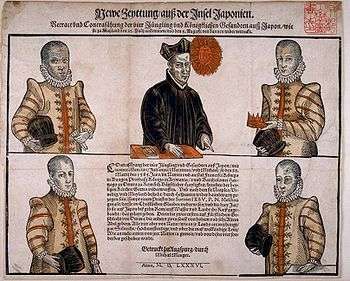Tenshō embassy

Top, from left to right: Julião Nakaura, Father Mesquita, Mancio Itō.
Bottom, from left to right: Martinho Hara, Miguel Chijiwa.
The Tenshō embassy (Japanese: 天正の使節, named after the Tenshō Era in which the embassy took place) was an embassy sent by the Japanese Christian Lord Ōtomo Sōrin to the Pope and the kings of Europe in 1582. The embassy was led by Mancio Itō (伊東 マンショ Itō Mansho, 1570–1612), a Japanese nobleman, who was the first official Japanese emissary to Europe.
Embassy
The idea of sending a Japanese embassy to Europe was originally conceived by the Jesuit Alessandro Valignano, and sponsored by the three Kirishitan daimyos Ōmura Sumitada (1532–1587), Ōtomo Sōrin (1530–1587) and Arima Harunobu (1567–1612). Mancio Itō was chosen to act as a spokesman for the group dispatched by Ōtomo Sōrin, who was daimyō of the Bungo Province on Kyūshū and a close relative of Mancio's father; Shurinosuke Itō. On February 20, 1582, Mancio Itō left Nagasaki in company with three other noblemen:
- Miguel Chijiwa (千々石 ミゲル Chijiwa Migeru)
- Julião Nakaura (中浦 ジュリアン Nakaura Jurian)
- Martinho Hara (原 マルチノ Hara Maruchino)
They were accompanied by two servants, their tutor and interpreter Diego de Mesquita, and their mentor Valignano, who only accompanied them as far as Goa in Portuguese India, where he was to take up new responsibilities. On their way to Lisbon, where they arrived in August 1584, they spent nine months visiting the Portuguese territories of Macau, Kochi and Goa. From Lisbon, the ambassadors went on to Rome, which was the main goal of their journey. In Rome, Mancio Itō became an honorary citizen and taken into the ranks of European nobility with the title Cavaliere di Speron d’oro ("Knight of the Golden Spur"). During their stay in Europe, they met with King Philip II of Spain; Francesco I de' Medici, Grand Duke of Tuscany; Pope Gregory XIII; and his successor Pope Sixtus V.
The ambassadors arrived back in Japan on July 21, 1590. On their eight-year-long voyage they had been instructed to take notes. These notes provided the basis for the De Missione Legatorum Iaponensium ad Romanam Curiam ("The Mission of the Japanese Legates to the Roman Curia"), a Macau-based writing by Jesuit Duarte de Sande published in 1590.
The four were subsequently ordained as the first Japanese Jesuit fathers by Alessandro Valignano.
Mancio Itō died in Nagasaki on November 13, 1612. Martinho Hara was banished from Japan by the Tokugawa Shogunate in 1614, and acted in Macau. He died in Macau on October 23, 1629. Miguel Chijiwa left the Society of Jesus before 1601, and died in Nagasaki on January 23, 1633. The reason for his secession is uncertain. Julião Nakaura was caught by the Tokugawa Shogunate, and died a martyr by torture in Nagasaki on November 21, 1633. He was beatified on November 24, 2008.
See also
- Bernardo, the Japanese, the first Japanese to visit Europe, in 1553.
- Hasekura Tsunenaga, another Japanese embassy to Europe in 1615.
Notes
- ↑ The World and Japan, p. 165.
References
- The world and Japan: the embassies of Tensho and Keicho (世界と日本:天正と慶長の使節 ), Sendai City Museum, 1995.
References
- The Christian Century in Japan 1549–1650 C.R. Boxer, ISBN 1-85754-035-2
- Biographical Dictionary of Japanese History Iwao, Seiichi (Tokyo 1978)
External links
Spiritual saga, the Japanese mission to Europe, by Michael Cooper